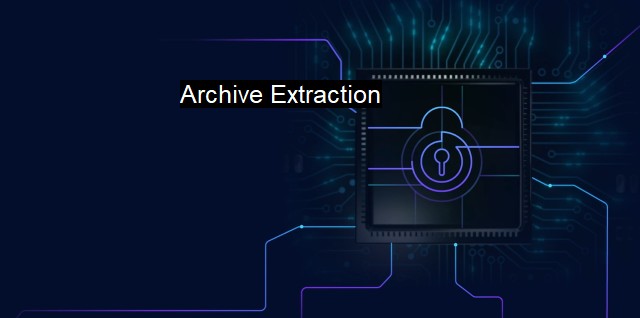What is Archive Extraction?
The Essentials of Archive Extraction in Cybersecurity and Antivirus Systems: Decrypting Malicious Files while Maintaining Data Integrity and Security
Archive extraction refers to the process by which a computer file or set of files (typically compressed) is restored or extracted from archived data for protecting data, identifying threats, or assisting in reparative software operations. Archive extraction is an important aspect that contributes significantly to keeping computing systems secure and running smoothly, especially critical in the contemporary digital landscape overflowing with potential cyber threats.Archives, by definition, are collections of data that are stored or backed up for long periods of time. Traditionally, this type of data is rarely accessed directly but kept for the purpose of ongoing referential necessity or recovery needs. In relation to cybersecurity, archives include software backups as well as various forms of data packs and file repositories that maintain an account of the various activities that occur throughout the course of computer usage.
Archive extraction comes into play when there's a need to analyze or recover these stored files. One of the key usages of archive extraction is in the diagnosis of system activities, especially in the presence of suspicious behavior that might indicate a malware or virus occurrence. This extraction allows cybersecurity professionals to delve into the data kits and closely observe the trends, behaviors, and incidents which might escape the naked eye on a regular timeline.
Antivirus software can automatically extract and scan archives to identify potential threats. Most contemporary quarantined threats may get archived, and extraction of these archives for study or analysis aids in the development of counter measures and improved cybersecurity solutions. archive extraction also enables the real-time monitoring of archived directories and registry entries, allowing the antivirus software to react instantly as soon as changes are detected.
It's critical to understand that extracting archives comes with potential risks. Security experts caution against careless or random extraction of files since this could potentially lead to the accidental release of hidden malware, defeating the very purpose of archive extraction in security circles. To protect against this risk, the extraction process usually takes place in a secure, isolated environment, also termed as 'sandbox,' in cybersecurity parlance. The sandbox adds a protective enclosure around the extraction process to keep potential threats contained.
There is a demand for highly advanced archive extraction techniques to anticipate potential integrated attacks and discrepancies, not just reactive solutions to deal with detected threats. Cybersecurity companies continually refine extraction tools to promote quicker identification and retraction of threats, making the analysis process more facile, efficient, robust, and anticipatory.
Archive extraction plays a crucial role in Incident Response (IR). When an organization faces a potential security threat, the Incident Response team utilizes archive extraction to collate necessary data by dissecting system activities, tracking potential sources of the threat, and identifying the full magnitude of the issue. This forms the foundation of devising an effective response strategy.
Archive extraction is an essential aspect of cybersecurity, playing a decisive role in data analysis, incident response, threat containment, and future cybersecurity enhancement measures. Although it poses its own challenges and necessitates vigilant handling, its importance remains paramount in maintaining robust cybersecurity practices. Therefore, the right blend of advanced tools, controlled environment, and expertise can leverage the potential of archive extraction in fortifying safeguards against looming cybersecurity threats.

Archive Extraction FAQs
What is archive extraction?
Archive extraction is the process of extracting or unpacking compressed files from an archive. An archive is a collection of files that have been bundled together and compressed into a single file to reduce their overall size. Archive extraction allows the files to be restored to their original state.How does archive extraction work in cybersecurity?
In cybersecurity, archive extraction is used to detect and analyze malware hidden inside compressed files. Antivirus programs use archive extraction to scan the contents of compressed files, looking for malicious code or suspicious behavior. If malware is detected, the antivirus program will either quarantine or delete the infected file to protect the computer system.What types of archives can be extracted?
Archive extraction can be performed on a variety of compressed file formats, including .zip, .rar, .7z, .tar, and .gz. Different archive extraction tools support different archive formats, so it's important to choose the right tool for the type of archive you want to extract.Is archive extraction safe?
Archive extraction is generally safe, but it can be risky if the compressed file contains malware or other malicious content. To minimize the risk of infection, it's recommended to use reliable antivirus software and to scan any downloaded files before extracting them. It's also important to only download files from trustworthy sources to avoid downloading infected files.| | A | | | B | | | C | | | D | | | E | | | F | | | G | | | H | | | I | | | J | | | K | | | L | | | M | |
| | N | | | O | | | P | | | Q | | | R | | | S | | | T | | | U | | | V | | | W | | | X | | | Y | | | Z | |
| | 1 | | | 2 | | | 3 | | | 4 | | | 7 | | | 8 | | |||||||